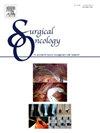PET/CT 与传统成像技术相比,在结直肠癌分期方面的诊断准确性和治疗效果
IF 2.3
4区 医学
Q3 ONCOLOGY
引用次数: 0
摘要
背景直到最近,正电子发射断层扫描(PET)CT 在结直肠癌(CRC)分期中的应用还仅限于检测晚期疾病的远处转移。该研究旨在评估 PET/CT 与单纯计算机断层扫描(CT)相比,对 CRC 结节和远处转移的分期准确性。方法对瑞士一家三级转诊中心 2015 年至 2021 年期间采用 PET/CT 和 CT 分期的 539 例 CRC 病例进行了回顾性分析。结果UICC分期(n = 479)分布如下:与 PET 相比,CT 单独预测结节受累的灵敏度为 55.2%(95%CI 5.7-59.7%),特异度为 66.7%(95%CI 62.4-70.9%)。CT 的特异性为 67.0%(95%CI 62.8-71.3%),PET 为 63.6%(95%CI 59.3-68.0%)。CT 的阳性预测值为 49.5%,而 PET 为 51.8%。CT和PET检测转移灶的灵敏度分别为53.6%(95%CI 49.1-58.1%)和82.5%(95%CI 79.1-85.9%)。本文章由计算机程序翻译,如有差异,请以英文原文为准。
Diagnostic accuracy and treatment benefit of PET/CT in staging of colorectal cancer compared to conventional imaging
Background
Until recently the use of positron emission tomography (PET) CT for staging in colorectal cancer (CRC) has been limited to the detection of distant metastasis in advanced disease. But with the introduction of neoadjuvant treatments in CRC, accurate pre-treatment staging has become more relevant.
Aims
The aim of the study was to assess the staging accuracy for nodal and distant metastasis of PET/CT compared to computed tomography (CT) alone in CRC. Secondary endpoints were overall survival (OS) and cost of CT compared to PET/CT.
Methods
A retrospective analysis of 539 cases with CRC staged with PET/CT and or CT between 2015 and 2021 in a Swiss tertiary referral center was performed. In 471 patients for nodal staging and 479 for staging of distant metastasis the clinical stage of both modalities was compared with pathological stage.
Results
The distribution of UICC stages (n = 479) was as follows: Stage I 62 cases (12.9 %), Stage II 127 cases (26.5 %), Stage III 199 cases (41.5 %), Stage IV 91 cases (19.0 %).
CT alone compared to PET was able to predict nodal involvement with a sensitivity of 55.2 % (95%CI 5.7–59.7 %) and 66.7 % (95%CI 62.4–70.9 %), respectively. The specificity was 67.0 % (95%CI 62.8–71.3 %) for CT and 63.6 % (95%CI 59.3–68.0 %) for PET. The positive predictive value was 49.5 % for CT vs. 51.8 % for PET. The sensitivity of metastasis detection was 53.6 % (95%CI 49.1–58.1 %) for CT and 82.5 % (95%CI 79.1–85.9 %) for PET.
Conclusions
PET/CT showed higher sensitivity in the detection of lymph node involvement and metastases in CRC patients compared to CT alone.
求助全文
通过发布文献求助,成功后即可免费获取论文全文。
去求助
来源期刊

Surgical Oncology-Oxford
医学-外科
CiteScore
4.50
自引率
0.00%
发文量
169
审稿时长
38 days
期刊介绍:
Surgical Oncology is a peer reviewed journal publishing review articles that contribute to the advancement of knowledge in surgical oncology and related fields of interest. Articles represent a spectrum of current technology in oncology research as well as those concerning clinical trials, surgical technique, methods of investigation and patient evaluation. Surgical Oncology publishes comprehensive Reviews that examine individual topics in considerable detail, in addition to editorials and commentaries which focus on selected papers. The journal also publishes special issues which explore topics of interest to surgical oncologists in great detail - outlining recent advancements and providing readers with the most up to date information.
 求助内容:
求助内容: 应助结果提醒方式:
应助结果提醒方式:


